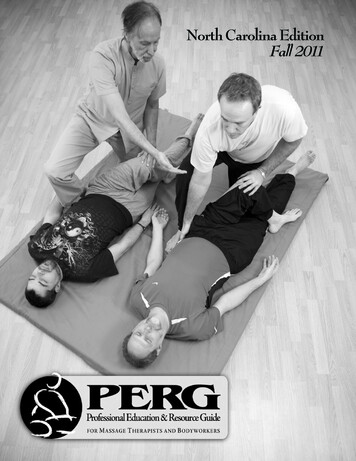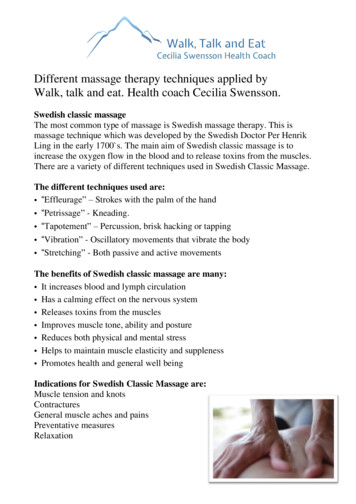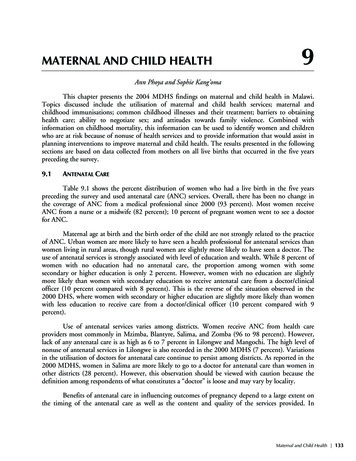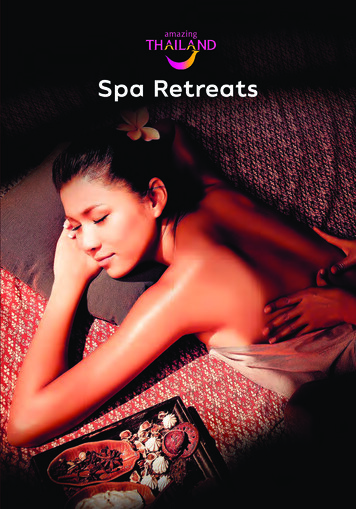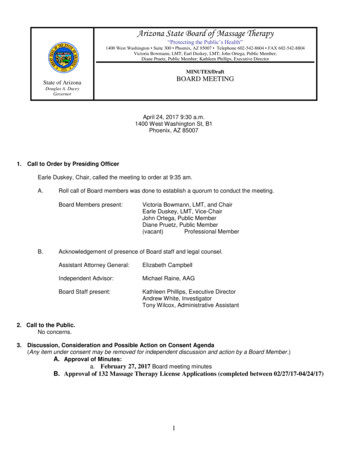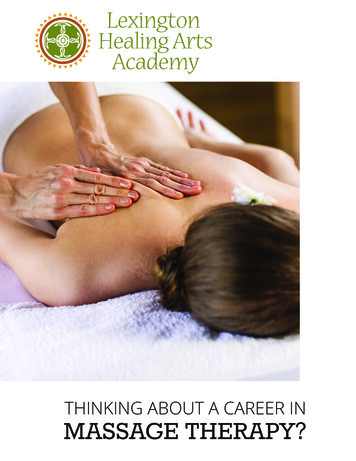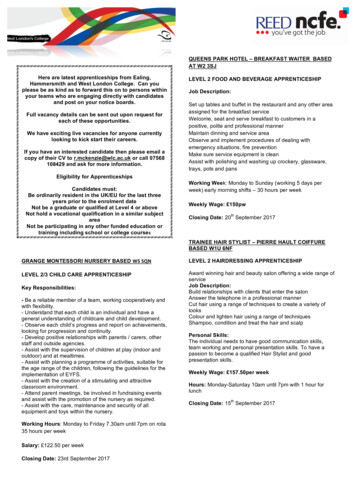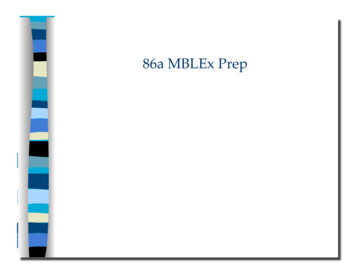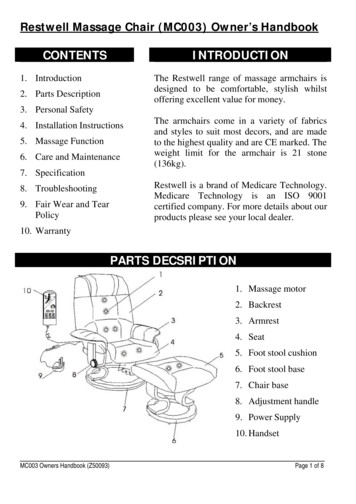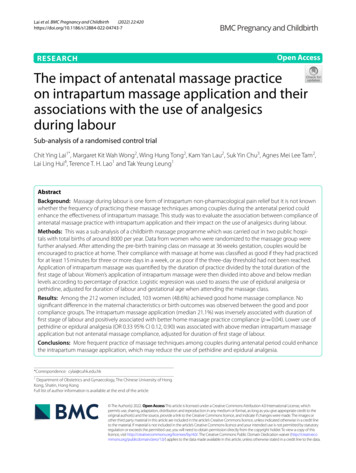
Transcription
(2022) 22:420Lai et al. BMC Pregnancy and -7Open AccessRESEARCHThe impact of antenatal massage practiceon intrapartum massage application and theirassociations with the use of analgesicsduring labourSub-analysis of a randomised control trialChit Ying Lai1*, Margaret Kit Wah Wong2, Wing Hung Tong2, Kam Yan Lau2, Suk Yin Chu3, Agnes Mei Lee Tam2,Lai Ling Hui4, Terence T. H. Lao1 and Tak Yeung Leung1AbstractBackground: Massage during labour is one form of intrapartum non-pharmacological pain relief but it is not knownwhether the frequency of practicing these massage techniques among couples during the antenatal period couldenhance the effectiveness of intrapartum massage. This study was to evaluate the association between compliance ofantenatal massage practice with intrapartum application and their impact on the use of analgesics during labour.Methods: This was a sub-analysis of a childbirth massage programme which was carried out in two public hospitals with total births of around 8000 per year. Data from women who were randomized to the massage group werefurther analysed. After attending the pre-birth training class on massage at 36 weeks gestation, couples would beencouraged to practice at home. Their compliance with massage at home was classified as good if they had practicedfor at least 15 minutes for three or more days in a week, or as poor if the three-day threshold had not been reached.Application of intrapartum massage was quantified by the duration of practice divided by the total duration of thefirst stage of labour. Women’s application of intrapartum massage were then divided into above and below medianlevels according to percentage of practice. Logistic regression was used to assess the use of epidural analgesia orpethidine, adjusted for duration of labour and gestational age when attending the massage class.Results: Among the 212 women included, 103 women (48.6%) achieved good home massage compliance. Nosignificant difference in the maternal characteristics or birth outcomes was observed between the good and poorcompliance groups. The intrapartum massage application (median 21.1%) was inversely associated with duration offirst stage of labour and positively associated with better home massage practice compliance (p 0.04). Lower use ofpethidine or epidural analgesia (OR 0.33 95% CI 0.12, 0.90) was associated with above median intrapartum massageapplication but not antenatal massage compliance, adjusted for duration of first stage of labour.Conclusions: More frequent practice of massage techniques among couples during antenatal period could enhancethe intrapartum massage application, which may reduce the use of pethidine and epidural analgesia.*Correspondence: cylai@cuhk.edu.hk1Department of Obstetrics and Gynaecology, The Chinese University of HongKong, Shatin, Hong KongFull list of author information is available at the end of the article The Author(s) 2022. Open Access This article is licensed under a Creative Commons Attribution 4.0 International License, whichpermits use, sharing, adaptation, distribution and reproduction in any medium or format, as long as you give appropriate credit to theoriginal author(s) and the source, provide a link to the Creative Commons licence, and indicate if changes were made. The images orother third party material in this article are included in the article’s Creative Commons licence, unless indicated otherwise in a credit lineto the material. If material is not included in the article’s Creative Commons licence and your intended use is not permitted by statutoryregulation or exceeds the permitted use, you will need to obtain permission directly from the copyright holder. To view a copy of thislicence, visit http:// creat iveco mmons. org/ licen ses/ by/4. 0/. The Creative Commons Public Domain Dedication waiver (http:// creat iveco mmons. org/ publi cdoma in/ zero/1. 0/) applies to the data made available in this article, unless otherwise stated in a credit line to the data.
Lai et al. BMC Pregnancy and Childbirth(2022) 22:420Page 2 of 8Trial registration: (CCRBCTR) Unique Trial Number CUHK CCRB0 0525.Keywords: Antenatal massage compliance, Intrapartum massage application, Pethidine, Epidural analgesiaBackgroundWomen rank labour pain as the topmost painful lifeexperience [1]. Fear and anxiety can induce muscle tension and further intensify the perception of pain [2].Pharmacological pain relief, the most frequently usedform of labour pain management, is effective but costlyand not free of side effects [3, 4]. The most effective pharmacological pain relief is epidural analgesia, the use ofwhich may cause numbness and limit the patients’ mobilization [5]. Thus women are ambivalent towards the useof epidural analgesia despite its effectiveness in pain control, as they are often disappointed with themselves fornot being able to accomplish a natural birth [6]. Hence,non-pharmacological analgesic methods become theonly alternative to women who want to maintain theirwell-being throughout the labour process [7].One of the most commonly studied non-pharmacological pain relief methods is massage. Massage worksthrough the application of pressure on parts of the bodyto block the transmission of pain impulses to the brain,and may improve blood flow and oxygenation of tissues[8]. However, its reported analgesic effects during labourare inconsistent. A number of randomized controlled trials have demonstrated the efficacy of massage in reducing or delaying the use of epidural analgesia [9, 10],lowering pain intensity [11–15] and reducing the incidence of depressed mood [16]. Another study reportedno difference in both pain score and the use of intrapartum analgesia with the use of massage [17]. However, allthese studies have focused on the impact of intrapartummassage on their respective outcome measures. Thesestudies either did not include antenatal massage practiceas their intervention [11–15] or have only assessed theeffect of pre-birth massage training on labour outcomes[9, 16, 17].There are only three reported trials on pre-birth training of massage techniques, but none of them had lookedinto the relationship between antenatal massage practicewith the effectiveness of intrapartum pain relief or theneed to use other forms of analgesia [9, 16, 17]. We havepreviously conducted a clinical trial in which healthy,pregnant, nulliparous women were randomized to a prebirth massage training group and a control group (whowere not trained in massage techniques and under usualcare only), and found lower intrapartum use of pharmacological pain relief modalities in the pre-birth massagetraining group [18]. A sub-analysis was conducted aimingfirstly to examine, within the pre-birth training group,the association between compliance of antenatal massagepractice with intrapartum massage application; and secondly their impact on the use of pain analgesics duringlabour.MethodsThis is a sub-analysis of our Randomized ControlledTrial (RCT) conducted on 233 healthy low risk nulliparous women of Chinese ethnicity who carried a singletonpregnancy and were planned for vaginal delivery. Thosewomen who indicated that no partner would be presentduring birth, and those who actually delivered in hospitals other than the study hospitals were excluded fromthe study. The details of the massage programme hasbeen described before [18]. In brief, the women wererandomized into the massage or the control group (withstandard care) at 36 weeks of gestation. Women allocatedto the massage group received a 2-hour pre-birth massagetraining session with their partners from 36 weeks gestation. The programme content was based on the childbirthmassage programme developed by Linder Kimber at theChildbirth Essentials, which consists of multiple components including massage, breathing and visualization[19]. The trainers were midwives accredited as trainers ofthe LK Massage Programme. Couples who consented tothe study were taught relaxation and pain relief massagetechniques together with controlled breathing and visualization. Relaxation techniques included massage overthe temple area, arms, upper legs, whole back, and shoulders. Pain relief techniques included massage over thesacral region as well as practicing controlled breathingand visualization during the massage. Participants wereadvised to adopt various positions, such as lying in bedor maintaining an upright or sitting position, accordingto different types of massage received. They were advisedto practice for at least 15 minutes daily; three times aweek, and preferably before bedtime. The participantswere instructed to record the time spent on practice eachday until the day of delivery and to submit this practicerecord to research staff upon admission for birth.Exposure – Antenatal massage complianceand intrapartum massage applicationAntenatal massage practice was quantified by the numberof days with practice for at least 15 minutes/day, betweenthe massage class and delivery. The women’s antenatalmassage compliance was classified as ‘good’ if they hadon average practiced the massage techniques for three or
Lai et al. BMC Pregnancy and Childbirth(2022) 22:420more days in a week. This demarcation was made withreference to Kimber’s study in 2008, which concludedthat 46.7% women could practice three or more timesper week [17]. Breathing and visualization were difficultto quantify and therefore not recorded as a compliancecriteria in this study. Nevertheless, couples were encouraged to practice all these programme components whenperforming massage at home.Intrapartum massage application was measured by theduration (in minutes) of massage during the first stageof labour and was recorded by midwives. Applicationof intrapartum massage was calculated as proportionof first stage of labour with massage, i.e. the duration ofmassage (in minutes) divided by the total duration of thefirst stage of labour (in minutes). The level of intrapartummassage application is then categorised into above, at orbelow median respectively. Again, the components ofcontrolled breathing and visualisation were not assessedand recorded but couples would be reminded to practiceduring the intrapartum massage application.OutcomeUse of epidural analgesia or pethidine injection duringlabour.Statistical analysisMaternal baseline characteristics by massage practice athome and during labour were compared using chi-squaretests (for categorical variables), t-test (for continuousPage 3 of 8variables with normal distribution) and Mann-Whitney U Test (for continuous variables with skeweddistribution).Multiple logistic regression was used to assess the associations of antenatal massage practice and intrapartummassage compliance with the use of pethidine or epiduralanalgesia. The statistical analyses were performed usinga commercial statistical package SPSS version 26 and theR version 4.0.1 (R Foundation for Statistical Computing,Vienna, Austria).ResultsAntenatal massage complianceFrom the total 233 women randomized to the massagegroup in the RCT, 21 did not return their home practicerecord, leaving 212 in the final analysis. The participantsattended massage class from 36.0 to 38.1 gestationalweeks (median 36.4 weeks), and delivered at 36.9 to41.6 weeks gestation (median 39.6 weeks). The duration from massage class to delivery ranged from 5 daysto 38 days. Figure 1 shows the numbers of women whohave not yet delivered and the proportion of womenthat practiced massage for at least 15 min a day, whichreached a maximum of 61.8% on day 3. This percentagethen declined gradually to about 45% after 2 weeks, 30%on day 30, and dropped steeply afterwards. The massagepractice of 103 out of 212 women (48.6%) were classified as good compliance based on our pre-set criteria.Table 1 shows that the maternal characteristics betweenwomen with good and poor compliance were similar inFig. 1 Percentage of women who practiced antenatal massage at home for at least 15 minutes per day, starting from completion of massagetraining till childbirth
Lai et al. BMC Pregnancy and Childbirth(2022) 22:420Page 4 of 8Table 1 Comparison of maternal characteristics between women with good compliance and those with poor compliance ofantenatal massage practiceAntenatal massage practiceaGood compliance N 103Poor compliance N 109p-valuesMaternal CharacteristicsAge mean ( / SD)31.2 (3.8)31.3 (3.6)0.98Height mean ( / SD, cm)157.9 (5.2)158.9 (5.7)0.21BMI at first booking mean ( / SD)26.4 (3.0)26.4 (3.3)0.99 Secondary30 (29.1)30 (27.5) Tertiary or above73 (70.9)79 (72.5) Housewives20 (19.4)20 (18.3) Nonprofessional60 (58.3)73 (67.0) Professional23 (22.3)16 (14.7) HK 2000012 (11.7)29 (18.3) HK 20000 to HK 4000051 (49.5)55 (50.5) HK 4000040 (38.8)34 (31.2)36.6 (36.0, 38.1)36.4 (36.0, 37.7)Education (%)0.79Occupation (%)0.31Income (%)Gestation at massage class median (IQR)0.290.01Pre-labour CharacteristicsGestation at delivery median (IQR)39.7 (36.9,41.4)39.6 (37.1,41.6)0.4321 (15, 26)21 (14.5, 28)0.5651 (49.5)49 (44.5)0.51 Post date8 (15.7)13 (26.5) Ruptured membranes20 (39.2)13 (26.5) Placental degeneration9 (17.6)6 (12.2) Infection risk7 (13.7)10 (20.4) Fetal problem7 (13.7)7 (14.4)Median (IQR) interval between massage class to delivery(days)Induction of labour (%)Reasons for induction of laboura0.44Good compliance was defined as antenatal massage 15mins/day for 3 days or more per weekterms of distributions of maternal age, BMI, educationlevels, occupation and family income. The women whopracticed good compliance attended the massage class atslightly later gestation (median 36.6 weeks vs 36.4 weeks;p 0.01), but there was no significant difference in termsof the median gestation at delivery or the need of induction of labour (Table 1). The median duration from massage class to delivery was 21 days, which was the same inwomen who practiced good compliance and those whodid not (Table 1).Intrapartum massage applicationIntrapartum massage application was calculated by dividing the duration of massage by the duration of the firststage of labour. The median duration of the first stage oflabour was 405 minutes (IQR 260, 624), and the medianduration of intrapartum massage was 100 minutes (IQR35, 195). The longer the first stage of labour, the longerthe total duration couples performed intrapartum massage (Spearman’s coefficient rho 0.39, p 0.0001). Theoverall median application % of intrapartum massage was21.1% (IQR 10.3, 46.6), and hence 110 women and 102women were classified as above and below median application respectively. Among the 90 women with first stageof labour lasting 6 hours or less, their median massageapplication was 28.1% (IQR 9.4, 64.9), which was higherthan that of the 89 women (21.5%; IQR 13.9, 39.3) and33 women (20.1%; IQR 8.1, 32.3) whose first stages wererespectively 6–12 hours and 12 hours, although thesedifferences were not statistically significant. No significant difference in the maternal characteristics and birthoutcomes was found with respect to the degree of intrapartum massage application (Table 2).Table 3 shows the association of antenatal massagepractice with intrapartum massage application during first stage of labour. Women with good intrapartum
Lai et al. BMC Pregnancy and Childbirth(2022) 22:420Page 5 of 8Table 2 Comparison of maternal characteristics and birthoutcomes between intrapartum massage applicationTable 3 Association of antenatal massage practice withintrapartum massage application during first stage of labouraIntrapartum massage application(Median: 21.1% IQR 10.3–46.6) MedianN 110 / MedianN 102P valuesIntrapartum massage application(Median: 21.1% IQR 10.3–46.6)Antenatal massage practiceAbove medianN 110 (%)At orbelowmedianN 102(%)61 (55.5)42 (41.2)49 (44.5)60 (58.8)Maternal CharacteristicsAge mean ( / SD)31.3 (3.8)31.2 (3.7)0.98Height mean ( / SD, cm)158.6 (5.2)158.2 (5.8)0.6026.3 (3.2)26.5 (3.1)0.65BMI at first booking mean( / SD)Education (%)0.73 Secondary30 (27.3)30 (29.4) Tertiary or above80 (72.7)72 (70.6)Occupation (%) Housewives18 (16.4)22 (21.6)67 (60.9)66 (64.7) Professional25 (22.7)14 (13.7) HK 2000014 (12.7)18 (17.6) HK 20000 to HK 4000058 (52.7)48 (47.1) HK 4000038 (34.5)36 (35.3)15 (14.6)10 (9.2)Income (%)a0.04Good (N 103)Poor (N 109)Good compliance was defined as antenatal massage 15mins/day for 3 days ormore per weekTable 4 Use of pharmacological pain relief methods byantenatal massage compliance, intrapartum massageapplication, and duration of labour0.55Reasons for augmentation oflabourn0.220.42 Poor progress5 (33.3)6 (60.0) Inadequate uterine contractions5 (33.3)2 (20.0) Infection risk5 (33.3)2 (20.0)50 (45.5)40 (39.2) 6–12 hours45 (40.9)44 (43.1) 12 hours15 (13.6)18 (17.6) Normal vaginal delivery87 (79.1)75 (73.5) Instrumental delivery12 (10.9)15 (14.7) Caesarean section11 (10.0)12 (11.8)Duration of first labourN 22 (%) OR (95% CI)p-value for ORAntenatal massage compliance Good ( 15minsfor 3 days or moreper week)103 11 (50)0.73 (0.28, 1.91) Poor (otherwise)109 11 (50)1.000.52aIntrapartum massage application (% labour duration with massage) (median 21.1% IQR 10.3–46.6)0.58Mode of deliveryUse of Pethidine/EpiduralaBirth Outcomes 6 hoursa0.20 NonprofessionalAugmentation of labourOverall compliancep valuea Above median110 6 (27.3)0.33 (0.12, 0.90) Below median102 16 (72.7)1.00Duration of first stage labour (hours) 6 6 to 120.620.03 12 (referentgroup)904 (18.2)0.10 (0.03, 0.38) 0.001898 (36.4)0.25 (0.09, 0.71)3310 (45.5)1.000.01aAdjusted for duration of labour (below 6 hours, 6 to 12 hours or above 12 hours)and gestational age when attending massage classaIntrapartum application was defined as the % of first stage of labour withmassage practicemassage application were statistically significantly associated with good antenatal massage compliance overall(p 0.04).Associations of antenatal massage practiceand intrapartum massage application with the useof pethidine or epidural analgesiaTwenty two (10.4%) women requested and used eitherpethidine or epidural analgesia for intrapartum painrelief (Table 4). The proportion of women using these twoforms of pharmacological analgesia was not significantlydifferent between the groups with good versus poor antenatal massage compliance, but was related to the duration of the first stage of labour and the application ofintrapartum massage (Table 4). Only 4 out of 90 womenwhose labour duration lasting 6 hours or less used pethidine or epidural analgesia, which was significantly lowerthan that among those with labour duration longer than12 hours (OR 0.10 CI 0.03, 0.38). Furthermore, the proportion of women who gave birth within a normal labourduration (within 6 to 12 hours) received fewer doses ofpethidine or epidural analgesia than those whose duration of labour was more than 12 hours (OR 0.25 CI 0.09,0.71). Above median intrapartum massage application
Lai et al. BMC Pregnancy and Childbirth(2022) 22:420was associated with a 68% lower use of pethidine or epidural analgesia (OR 0.33 95% CI 0.12, 0.89), adjustedfor potential confounders including the duration oflabour, and gestational age when attending massage class(Table 4).DiscussionThis is the first study to look into the impact of antenatal massage practice on intrapartum massage applicationas well as their association with the use of pharmacological analgesia. The results showed that compliance toantenatal massage practice was positively correlatedwith intrapartum massage application, which in turn wasassociated with a lower use of pethidine or epidural analgesia. However, antenatal massage compliance alone wasnot associated with the use of these two analgesics during labour. It was observed that women who practicedantenatal massage for 15 minutes, 3 days a week, from36 weeks gestation onwards, applied massage more during labour. About half of the women who participatedin this study reached such compliance of antenatal practice, which was similar to a previous smaller-scale studyreporting a similar compliance of 10 minutes of practice,3 days a week [17]. Around 50% of women gave birthby day 21 after the massage class and their compliancemaintained at 40% or above within these 21 days. Thestudy suggested that starting the massage practice a fewweeks before birth may allow couples to become morefamiliar with applying the massage skills. Further studiesare required to determine the optimal time to commenceantenatal massage practice in order to achieve optimalapplication during the intrapartum period.Greater intrapartum massage application was associated with lower use of pethidine or epidural analgesiaduring labour. However, the compliance to antenatalmassage alone was not associated with a lower use ofpethidine or epidural analgesia during labour, the use ofwhich is more likely due to stronger factors such as theduration of labour. Women experiencing shorter labourduration in our study had particularly lower consumption of pethidine and epidural analgesia. This may bedue to the fact that women experiencing a shorter labourduration can manage without analgesics since massagewas adequate. A longer labour duration may decrease theparticipants’ pain threshold and partners might becamefatigued with massage application, thereby increasingthe need of pethidine or epidural analgesia. This is alsoconsistent with the primary analysis of our RCT, whichshowed an increased use of pharmacological pain reliefmodalities in the control group when compared to themassage group [18]. Duration of labour is a predictingfactor that affects the use of analgesia in labour in addition to parity and experience of previous labour [20]. ThePage 6 of 8current study group is exclusively nulliparous and therefore duration of labour might be the only strong predicting factor in using pain analgesics.This study shows that the use of pharmacological painrelief does not differ according to antenatal massagecompliance, implying that an on-site massage class rightbefore labour should still be considered and encouragedfor couples who are keen to avoid the use pethidine orepidural analgesia. Nevertheless, since overall goodantenatal massage compliance is related to subsequentgreater application of intrapartum massage, a structuredpre-birth childbirth massage programme should still beconsidered in equipping couples with the skills of massage and better preparation for labour.Limitations of the studyThe median intrapartum massage application proportion was 21.1% which indicated half of the couples in themassage group spending around one fifth of the labourtime applying massage. The optimal duration of massageduring labour cannot be concluded. It is noted that somelocal practice may be barriers to the massage practice.For example, routine intrapartum continuous fetal heartmonitoring might limit women’s mobility and interferewith some massage techniques applied in an uprightposture. Revisiting the practice of continuous fetal heartmonitoring is necessary in future. In healthy low riskwomen, intermittent auscultation should be consideredor wireless cardiotocographic monitoring can be usedwhen deemed necessary. Another potential barrier concerns the availability of partners who are not allowed tobe present during emergency situations involving otherparturients in the labour ward. However, the continuouspresence of the partner throughout the labour processcould be an important factor for the success of the intrapartum massage by giving both practical and emotionalsupport to the women [21–23]. To support and enhancelabour companionship is another important factor tomaximize the application of massage during labour to agreater extent.The current study is the largest study to look intoboth antenatal compliance and intrapartum applicationof the massage programme. It is noted that this current study focused on the compliance of massage onlyand did not evaluate other components of the massageprogramme such as controlled breathing and visualization. There are two main reasons. First, the massagewas practiced in the presence of the women’s partners,while women could practice controlled breathing andvisualisation on her own at any time. Hence it is moreobjective to assess the compliance to massage with ameasurable duration. Second, our study aims at investigating the impact of the massage programme on the
Lai et al. BMC Pregnancy and Childbirth(2022) 22:420Page 7 of 8intrapartum massage application by the women’s partners. In this regard, the partners’ skill, experience andcompliance, which were expected to be acquired during the antenatal period is the foremost influential factor when compared to maternal practice of breathingand visualisation. Hence, this study cannot determinewhether maternal practice of controlled breathing andvisualisation will have potential impact on the programme. A thorough evaluation of the childbirth massage programme should be considered in future and asystem of breathing and visualization quantificationshould be established.Intrapartum massage application was associated withlowered use of analgesics during labour. Whether it isequally effective by performing bedside practice aloneduring labour or home practice during antenatal periodto enhance massage skills beforehand remains uncertain. Future randomized controlled trials on antenataland intrapartum massage can be considered to explorethe efficacy of the models of practice.DeclarationsConclusionIntrapartum massage practice, rather than antenatalmassage, was associated with the reduced use of pethidine or epidural analgesia during labour. However,antenatal massage practice may enhance the intrapartum massage application, suggesting its indirect valuein relieving labour pain. Non-pharmacological labourassistance program appears to be an option associatedwith the lesser use of the pethidine or epidural analgesia during labour.References1. Melzack R. The myth of painless childbirth (the John J. Bonica lecture).Pain. 1984;19(4):321–37 https:// doi. org/ 10. 1016/ 0304- 3959(84) 90079-4.2. Dick-Read G. Childbirth without fear: the principles and practice of natural childbirth: Pinter & Martin Publishers; 2004.3. Anim-Somuah M, Smyth RM, Cyna AM, Cuthbert A. Epidural versusnon-epidural or no analgesia for pain management in labour. CochraneDatabase Syst Rev. 2018;(5) https:// doi. org/ 10. 1002/ 14651 858. CD000 331. pub4.4. Bell ED, Penning DH, Cousineau EF, White WD, Hartle AJ, Gilbert WC, et al.How much labor is in a labor epidural? Manpower cost and reimbursement for an obstetric analgesia service in a teaching institution. Anesthesiology. 2000;92(3):851–8 https:// doi. org/ 10. 1097/ 00000 542- 20000 3000- 00029.5. Mayberry LJ, Clemmens D, De A. Epidural analgesia side effects, cointerventions, and care of women during childbirth: a systematic review.Am J Obstet Gynecol. 2002;186(5):S81–93.6. Hidaka R, Callister LC. Giving birth with epidural analgesia: the experienceof first-time mothers. J Perinat Educ. 2012;21(1):24–35.7. Henrique AJ, Gabrielloni MC, Rodney P, Barbieri M. Non-pharmacologicalinterventions during childbirth for pain relief, anxiety, and neuroendocrine stress parameters: a randomized controlled trial. Int J Nurs Pract.2018;24(3):e12642 https:// doi./ 10. 1111/ ijn. 12642.8. Mc Nabb MT, Kimber L, Haines A, McCourt C. Does regular massage fromlate pregnancy to birth decrease maternal pain perception during labourand birth?—a feasibility study to investigate a programme of massage,controlled breathing and visualization, from 36 weeks of pregnancy untilbirth. Complement Ther Clin Pract. 2006;12(3):222–31 https:// doi. org/ 10. 1016/j. ctcp. 2005. 12. 006.9. Levett KM, Smith C, Bensoussan A, Dahlen HG. Complementary therapiesfor labour and birth study: a randomised controlled trial of antenatal integrative medicine for pain management in labour. BMJ Open.2016;6(7):e010691 https:// doi: 10. 1136/ bmjop en- 2015- 010691.10. Janssen P, Shroff F, Jaspar P. Massage therapy and labor outcomes: arandomized controlled trial. Int J Ther Massage Bodywork. 2012;5(4):15https:// doi. org/ 10. 3822/ ijtmb. v5i4. 164.11. Gallo RBS, Santana LS, Ferreira CHJ, Marcolin AC, PoliNeto OB, Duarte G,et al. Massage reduced severity of pain during labour: a randomised trial.Aust J Physiother. 2013;59(2):109–16.12. Mortazavi SH, Khaki S, Moradi R, Heidari K, Vasegh Rahimparvar SF. Effectsof massage therapy and presence of attendant on pain, anxiety andAbbreviationsLK Massage: Linda Kimber Massage; RCT : Randomised controlled trial.AcknowledgementsWe sincerely thank all women and their partners who participated in thisstudy. We are also grateful to Ms. Linda Kimber, Midwife/Director, and Ms.Mary McNabb, Scientific Advisor and Academic Midwife, both of ChildbirthEssentials, Banbury, United Kingdom, for training the midwives involved in thepresent study and for advising the authors on the study design.Authors’ contributionsCYL designed the study, wrote the study protocol, undertook data analysisand drafted the manuscript. MKWW and WHT developed the data collectiontools, AMLT, SYC, KYL collected data. LLH reviewed statistical methods, THLamended figures, tables and revised the manuscript, TYL critically reviewedand finalized the manuscript. All authors read and approved the finalmanuscript.FundingThis research received no specific grant from any funding agency in the public, commercial, or not-for-profit sectors.Availability of data and materialsThe datasets used and analyzed during current study are available from thecorresponding author on reasonable request.Ethics approval and consent to participateThis study was performed in accordance with the Declaration of Helsinkiand has been approved by the Joint Chinese University of Hong Kong-NewTerritories East Cluster Clinical Research Ethics Committee. The study has beenregistered at the Centre for Clinica
Antenatal massage practice was quantied by the number of days with practice for at least 15minutes/day, between the massage class and delivery. e women's antenatal massage compliance was classied as 'good' if they had on average practiced the massage techniques for three or Trial registration: (CCRBCTR) Unique Trial Number CUHK_C CRB00525.


